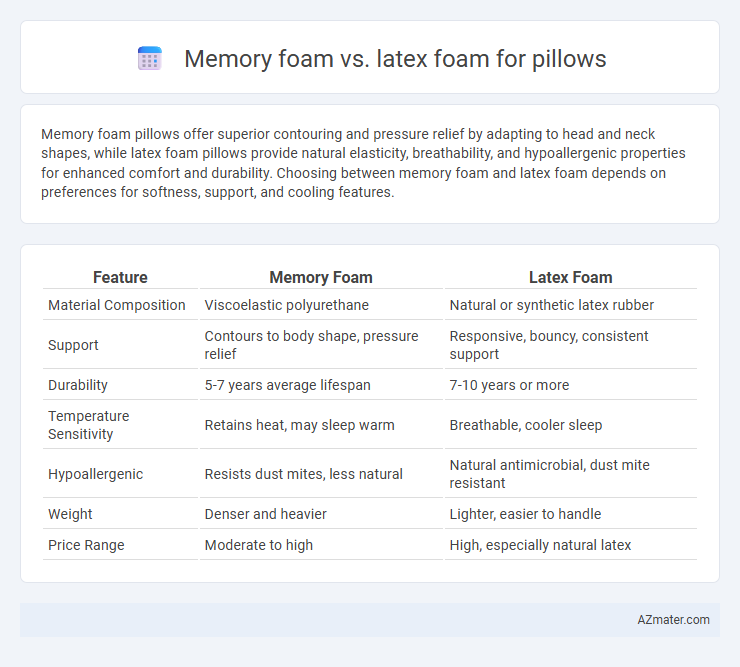Memory foam pillows offer superior contouring and pressure relief by adapting to head and neck shapes, while latex foam pillows provide natural elasticity, breathability, and hypoallergenic properties for enhanced comfort and durability. Choosing between memory foam and latex foam depends on preferences for softness, support, and cooling features.
Table of Comparison
| Feature | Memory Foam | Latex Foam |
|---|---|---|
| Material Composition | Viscoelastic polyurethane | Natural or synthetic latex rubber |
| Support | Contours to body shape, pressure relief | Responsive, bouncy, consistent support |
| Durability | 5-7 years average lifespan | 7-10 years or more |
| Temperature Sensitivity | Retains heat, may sleep warm | Breathable, cooler sleep |
| Hypoallergenic | Resists dust mites, less natural | Natural antimicrobial, dust mite resistant |
| Weight | Denser and heavier | Lighter, easier to handle |
| Price Range | Moderate to high | High, especially natural latex |
Introduction to Memory Foam and Latex Foam Pillows
Memory foam pillows are crafted from viscoelastic polyurethane, offering adaptive support by contouring to the shape of the head and neck, which helps in pressure relief and spinal alignment. Latex foam pillows, derived from natural or synthetic rubber, provide resilient, springy support with excellent breathability and durability, ideal for those seeking a balance of support and airflow. Both materials cater to different sleep preferences, where memory foam excels in personalized comfort and latex foam stands out for its natural hypoallergenic properties and responsiveness.
Composition and Material Differences
Memory foam pillows consist of viscoelastic polyurethane foam that responds to heat and pressure, contouring to the shape of the head and neck for customized support. Latex foam pillows are made from either natural latex harvested from rubber trees or synthetic latex blends, offering a resilient and buoyant feel with inherent antimicrobial properties. The key material difference lies in memory foam's temperature-sensitive, slow-rebounding structure versus latex foam's naturally breathable and elastic composition.
Comfort and Support: A Comparative Overview
Memory foam pillows conform to the head and neck by responding to body heat, offering personalized support that relieves pressure points and enhances spinal alignment. Latex foam pillows provide consistent support with a resilient and buoyant feel, maintaining shape and promoting airflow for cooler comfort throughout the night. Both pillow types balance comfort and support, with memory foam excelling in contouring ability and latex foam delivering durability and breathability for optimal sleep quality.
Pressure Relief and Ergonomics
Memory foam pillows provide superior pressure relief by contouring closely to the head and neck, evenly distributing weight to reduce stress points and promoting ergonomic spinal alignment. Latex foam offers resilient support with a slightly firmer feel, maintaining consistent shape and providing durable support that encourages proper neck and head posture during sleep. Both materials enhance ergonomics, but memory foam excels in pressure adaptation, while latex prioritizes breathability and bounce.
Temperature Regulation and Breathability
Memory foam pillows excel in pressure relief but often trap heat due to their dense structure, leading to less effective temperature regulation and breathability. Latex foam pillows feature an open-cell structure and natural ventilation channels that enhance airflow, providing superior temperature regulation and breathability compared to memory foam. These breathable properties make latex foam pillows an ideal choice for maintaining a cool and comfortable sleep environment.
Durability and Longevity
Latex foam pillows exhibit superior durability and longevity compared to memory foam, often lasting up to 8-10 years without significant sagging due to their natural resilience and resistance to body impressions. Memory foam pillows typically last 2-3 years before losing firmness and support, as the viscoelastic material tends to break down faster under constant pressure. The inherent antimicrobial and hypoallergenic properties of latex further contribute to its sustained performance over time, making it a more cost-effective and durable choice for long-term pillow use.
Hypoallergenic and Health Considerations
Memory foam pillows, made from viscoelastic polyurethane, offer contouring support but may emit VOCs that can irritate sensitive individuals, potentially affecting respiratory health. Latex foam pillows, derived from natural or synthetic rubber, are inherently hypoallergenic, resistant to dust mites and mold, making them a healthier option for allergy sufferers and asthma patients. Choosing latex foam promotes better indoor air quality and reduces the risk of allergic reactions compared to traditional memory foam pillows.
Price Comparison and Value for Money
Memory foam pillows typically cost between $30 and $100, offering excellent contouring support and pressure relief, which justifies the price for many users. Latex foam pillows range from $50 to $150, often priced higher due to their natural, hypoallergenic properties and durable elasticity that extends the product lifespan. When evaluating value for money, memory foam provides affordable comfort and support, while latex foam delivers superior breathability and longevity, making it a worthwhile investment for long-term use.
Environmental Impact and Sustainability
Memory foam pillows often rely on petroleum-based materials, resulting in higher carbon emissions and limited biodegradability compared to natural latex foam, which is derived from rubber trees and offers greater sustainability through biodegradability and renewability. Latex foam production typically supports sustainable harvesting practices, helping preserve forest ecosystems and reduce chemical pollutants associated with synthetic foams. Consumers seeking eco-friendly options prioritize natural latex pillows due to their lower environmental footprint, recyclability, and reduced reliance on fossil fuels.
Choosing the Right Pillow: Memory Foam vs Latex Foam
Memory foam pillows contour to the head and neck, providing pressure relief and personalized support, making them ideal for side and back sleepers seeking spinal alignment. Latex foam pillows offer natural elasticity and breathability, promoting airflow and durability, which benefits hot sleepers and those preferring a resilient, bouncy feel. Selecting the right pillow depends on individual comfort preferences, sleeping positions, and sensitivity to materials, with memory foam excelling in cushioning while latex foam stands out for hypoallergenic properties and ventilation.

Infographic: Memory foam vs Latex foam for Pillow
 azmater.com
azmater.com